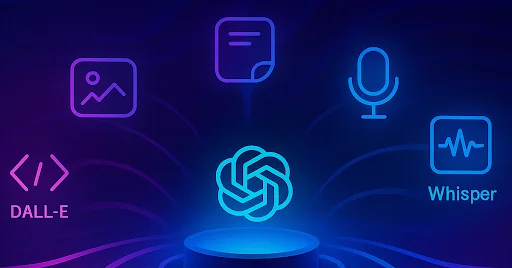The next major shift in Artificial Intelligence isn’t just about power. It’s about unification. OpenAI is preparing to launch GPT-5—but what’s equally important is the strategic move to merge all their flagship tools into one seamless platform. That means ChatGPT, DALL·E, Codex, Whisper, Memory, Browse, and even personal assistants will live in one AI operating system.
And that changes everything.
Here’s what’s coming, why it matters, and how to get ready now.
Continue your journey: This related article is worth your time.
What GPT-5 Means (And Doesn’t)
GPT-5 isn’t just a bigger model. It’s expected to:
- Natively support multimodal inputs: text, images, audio, possibly video
- Operate with longer memory windows—critical for workflow
- Understand tool usage context without explicit prompting
- Deliver agent-level reasoning across domains
- Be the center of OpenAI’s new platform-as-assistant initiative
But the more important part?
GPT-5 will be wrapped into a single app where all your AI tasks—writing, planning, coding, visual generation, email, voice, search—happen in one place.
That’s not evolution. That’s OS-level territory.
The End of AI Fragmentation
Right now, most users jump between:
- ChatGPT
- Notion AI
- Claude
- Gemini
- Midjourney
- Perplexity
- Superhuman AI
- Slack GPT
- Excel Copilot
- Whisper
- DALL·E
Each tool handles one slice of your thinking. And every switch kills momentum.
What OpenAI is doing with GPT-5 is removing friction:
- Search something? GPT-5 will look it up.
- Want to draft from that? Same window.
- Need images? DALL·E inside the chat.
- Want it read aloud? Whisper built-in.
- Want it to remember? Long-term Memory is default.
The tools disappear. The interface becomes thought-driven.
The Core Problem This Solves
Right now, generative AI is still interruptive. It helps—but it pulls you out of flow.
I ask ChatGPT for a plan → I go to Figma
I generate slides → I go to Keynote
I want an image → I go to Midjourney
I want to build a landing page → I open Webflow
I want to deploy → I switch to Vercel
And I lose energy every time.
GPT-5 in a unified platform closes that gap. It’s like your brain gets an OS-level upgrade.
Where I’m Already Testing This Flow
If you want to prep for GPT-5 now, you don’t wait.
You move your workflow into a space that already runs multiple models, supports all use cases, and consolidates context.
I’ve been running everything inside Chatronix—the only place where GPT-4, Claude, Gemini, Grok, Perplexity, and DeepSeek sit side-by-side.
Here’s what it enables:
- Write in GPT, fact-check in Perplexity, rewrite in Claude—in one click
- Generate code with Claude, debug with Grok
- Compare brand voices across models before shipping
- Switch from creative to technical tone with Turbo Mode
It’s the closest thing to a pre-GPT-5 interface that already works.
Table: What GPT-5 Unification Will Replace
| Today’s Tool | GPT-5 Unified Capability | What It Means |
| ChatGPT + Browse | GPT-5 with real-time web access | No more switching to Perplexity |
| DALL·E site | DALL·E inside chat thread | Visuals in workflow, not separate tab |
| Whisper / audio apps | GPT-5 with voice input + output | Live conversation, command-style flow |
| Memory (manual notes) | Persistent session memory | Context-aware replies 24/7 |
| Assistant APIs | GPT-5 as custom agents | Multistep tasks run with one instruction |
| Plugin ecosystem | Native tool integration | Plugins become services—not add-ons |
Prompt Engineering Will Change Forever
When all tools merge, prompts stop being specific. You’ll say:
“Help me launch this new product. I want branding, a landing page, and a GTM checklist.”
And GPT-5 will:
- Ask clarifying questions
- Build the site (w/ DALL·E assets)
- Draft the launch tweets
- Suggest influencer partners
- Schedule your follow-ups
- Monitor mentions post-launch
Right now, you’d need 6 tools. Then? One thread. One model. One loop.
Why This Isn’t Hype
There are 3 reasons to take this seriously:
- OpenAI just merged ChatGPT browsing, memory, voice, and DALL·E into one UI—already live in ChatGPT Pro
- API strategy is shifting toward assistants, not raw models
- Internal leaks and partner previews have pointed to an August–October GPT-5’s window
This is not a “coming soon” demo. It’s rollout in slow motion.
Extremely interesting developments from sources close to OpenAI and NVIDIA:
— Chris (@chatgpt21) August 5, 2025
•GPT-5 was reportedly trained using 170K–180K H100s
•Now fully multimodal (vision, audio, video input support likely live)
•Post-training, OpenAI is preparing for massive scale
GPT-5 has entered… pic.twitter.com/i01eYDuYjY
Final Thoughts
GPT-5 won’t just be smarter.
It will be quieter. Cleaner. More invisible.
You won’t realize you’re talking to a chatbot. You’ll feel like you’re moving through a workspace that thinks faster than you do—and simply helps.
The real leap isn’t in tokens. It’s in how little you need to explain yourself to get something done.
OpenAI is turning models into operating systems. And GPT-5 will be the first that feels like it was built for your entire work life—not just one task.
If you’re still switching tabs, waiting for the perfect prompt, or copy-pasting across apps—you’re already behind.
Start building your workflow stack in a unified AI space today.
That way, when GPT-5 arrives, you won’t be surprised.
You’ll be ready.
To explore all our latest posts in one place, be sure to visit the 2A Magazine.







